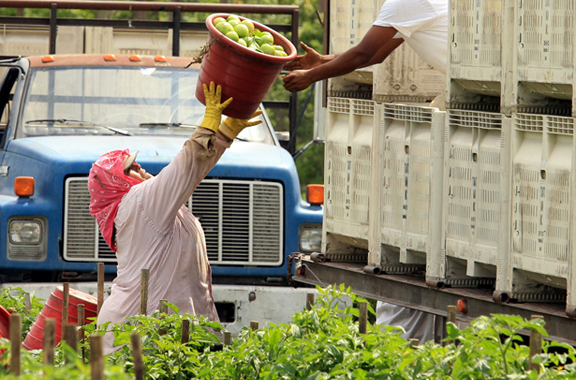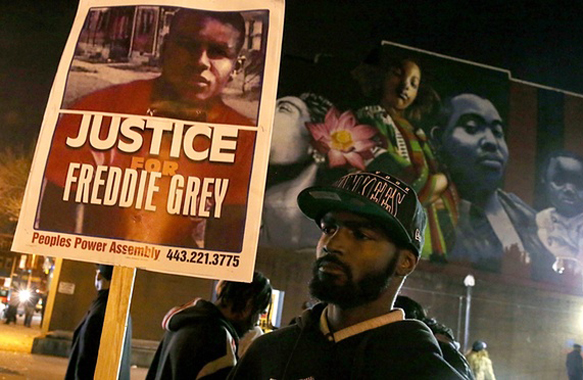Photograph; Farmworkers pick tomatoes in Immokalee, Florida. (AP Photo/Luis M. Alvarez)
By Greg Kaufmann | Originally Published at This Week in Poverty: Twelve Things You Can Do To Fight Poverty Now The Nation. on May 10, 2013 9:52 AM ET
This is a tough moment in the fight against poverty.
The sequester is the latest chapter in a time-honored tradition of kicking the poor when they are down. A do-nothing Congress certainly isn’t going to do something about poverty without pressure from the grassroots. And it seems that the only way most of the mainstream media will pay attention to the more than one in three Americans living below twice the poverty line—on less than $36,000 for a family of three—is if their lives make good fodder for tabloid television or play out in a courtroom drama.
That said, there are still plenty of people and groups fighting for real change, and plenty of ways you can get involved or stay engaged. I reached out to a handful of folks who dedicate their lives to fighting poverty in different ways. Here is what they asked people to do:
1) From Sister Simone Campbell, Sisters of Social Service, executive director of NETWORK: Support an increase in the minimum wage to more than $11 per hour.”
What people don’t know is that a large percentage of people living in poverty are workers who support their families on very small salaries. In fact, 57 percent of individuals and family members below the official poverty line either worked or lived with a working family member in 2011.
Pope Francis said on May 1, 2013, that all workers should make wages that allow them to live with their families in dignity. Contact your Senators and Representative to urge them to vote for a minimum wage (one that’s more than $11 an hour) and tipped minimum wage that reflect the dignity of all people.
2) From the Coalition of Immokalee Workers: Tell Publix: Help end sexual harassment, wage theft, and forced labor in the fields—join the Fair Food Program today.”
Until very recently, Florida’s fields were as famous for producing human rights violations—with countless workers suffering daily humiliation and abuse ranging from wage theft to sexual harassment and even forced labor—as they were for growing oranges and tomatoes.
Today, however, there is a new day dawning for farmworkers in Florida’s tomato fields. The CIW’s Fair Food Program is demanding a policy of zero tolerance for human rights abuses on tomato farms, and it’s working. The program sets the highest human rights standards in the fields today, including: worker-to-worker education on rights, a twenty-four-hour complaint line and an effective complaint investigation and resolution process—all backed by market consequences for employers who refuse to respect their workers’ rights.
The White House recently called the exciting new program “one of the most successful and innovative programs” in the world today in the fight to uncover—and prevent—modern-day slavery; and just last week United Nations investigators called it impressive” and praised its ”independent and robust enforcement mechanism.”
As the veteran food writer Barry Estabrook put it, thanks to the Fair Food Program, the Florida tomato industry is on the path from being one of the most repressive employers in the country…to becoming the most progressive group in the fruit and vegetable industry” today.
But we need your help to complete this transformation.
One of the country’s largest supermarket chains, Publix Super Markets, is refusing to support the Fair Food Program. Publix continues to buy tomatoes from growers in the old way, where workers have no access to the Fair Food Program’s proven protections. Rather than step up to the highest human rights standards, Publix continues to turn its back on the workers whose poverty helps fuel its record profits.
3) From Ralph da Costa Nunez, president and CEO, Institute for Children, Poverty, and Homelessness: Make a Personal Commitment to Helping Homeless Families.”
More than one-third of Americans who use shelters annually are parents and their children. In 2011, that added up to more than 500,000 people. Since 2007, family homelessness has increased by more than 13 percent. Indeed, there is a growing prevalence of child and family homelessness across America.
While it is important to track the federal, state and local policies that impact homelessness, we can’t forget about getting involved on a personal level with the growing numbers of families that are struggling since the Great Recession.
You can visit a local shelter, meet a homeless family and see first hand the damage poverty is doing to young mothers and children. Then, become a big brother or sister, a role model for these young families to help them dream again. You are meeting an immediate need while also helping to stem generational poverty.
You can also contact your local department of social services, United Way or religious organization to find out where the need is in your community. Also, speak with the homeless liaison at your local school to see what needs they have identified in your neighborhood. There are many ways that you (and your children) can help families right in your community. Here are a few other ideas.
4) From Dr. Deborah Frank, founder and principal investigator, Children’s Healthwatch: Fund the federal Low Income Home Energy Assistance Program (LIHEAP) at the maximum authorized level.”
Research by Children’s HealthWatch has shown that energy insecurity is associated with poor health, increased hospitalizations and risk of developmental delays in very young children, and that energy assistance can be effective in protecting children’s health. The Low Income Home Energy Assistance Program (LIHEAP) provides low-income households with assistance in paying their utility bills—particularly those that must spend higher proportions of their income on home energy. To be eligible for LIHEAP, families must have incomes at or below 150 percent of the federal poverty level—less than $35,000 annually for a family of four.
When Children’s HealthWatch compared children in families that do and do not receive LIHEAP assistance—after controlling for participation in SNAP and WIC—we found that children in families that received LIHEAP were less likely to be at risk of growth problems, more likely to have healthier weights for their age and less likely to be hospitalized when seeking care for acute medical problems.
As pediatricians and public health researchers, we at Children’s HealthWatch know that LIHEAP matters for the bodies and minds of young children. Even in these tough economic times, we believe it is critical that President Obama and Congress make a funding commitment that meets the heating and cooling needs of America’s youngest children.
But the President has proposed reducing funding for LIHEAP to $2.970 billion in his FY 2014 budget, down from $3.5 billion for the current fiscal year. (Even funding at the current level has left millions of households without the aid they need to cope with their home energy costs.)
Please join the National Fuel Fund’s call to fund LIHEAP at $4.7 billion in FY2014. Although that level is insufficient to meet the full needs of vulnerable households, it will enable states to end a trend over the last few years of needing to reduce the number of households served, cut benefits or both. Contact the President and your members of Congress today.
5) Sarita Gupta, executive director, Jobs with Justice/American Rights at Work and Co-Director, Caring Across Generations: Support of a living wage and basic labor protections for home care workers.”
Caring Across Generations is a campaign that unites people to change the long-term care system that supports each of us, our family members and our neighbors, to live and age in our own homes and communities. One of the key ways we can strengthen this system is to protect the 2.5 million people working as care givers in the United States. With a projected future demand for an additional 1.3 million workers over the next decade, homecare workers make up one of the largest occupations in the nation, yet many of them make below minimum wage.
In December 2011, at a White House ceremony surrounded by homecare workers, employers and people who rely on personal care services, President Obama announced plans for new regulations that would at long last guarantee federal minimum wage and overtime protections for most homecare aides. The moment capped decades of effort by advocates to revise the companionship exemption,” which lumps professional care workers with teenage babysitters, excluding most homecare aides from the basic labor protections that nearly all other American workers receive.
Following the White House announcement, the US Department of Labor published draft regulations in the Federal Register. During the public comment period, the proposed rule received 26,000 comments with almost 80 percent in favor of providing homecare workers with basic labor protections like minimum wage and overtime pay. But today, over a year after the public comment period closed, we are still waiting for a final rule to be announced.
Join Caring Across Generations and all of our partner organizations in the effort to push for basic minimum wage and overtime protections for care workers, and help us in our final push to ensure that the Obama Administration issues this long-awaited regulation to give 2.5 million care workers a path out of poverty. Visit www.caringacross.org to get involved with the campaign.
6) From Judith Lichtman, senior adviser, National Partnership for Women & Families: Urge Congress to pass the Healthy Families Act (H.R. 1286/S.631) and a national paid leave program”
More than 40 million workers in this country—and more than 80 percent of the lowest-wage workers—cannot earn a single paid sick day to use when they get the flu or other common illnesses. Millions more cannot earn paid sick days to use when a child is sick.
For these workers and families, paid sick days can mean the difference between keeping a job and losing it, or keeping food on the table and going hungry. Nearly one-quarter of adults say they have lost a job or been threatened with job loss for needing a sick day. And, for the average worker without paid sick days, taking just 3.5 unpaid days off is equivalent to losing a month’s worth of groceries for their family. To make matters worse, the majority of new parents cannot take any form of paid leave of any length to care for a child, pushing many into debt and poverty. The United States is one of only a handful of countries that does not have a national paid leave standard of some kind.
In a nation that claims to value families, no worker should have to lose critical income or be pushed into poverty because illness strikes or a child or family member needs care.
Urge members of Congress to support the Healthy Families Act, legislation that would guarantee workers the right to earn paid sick days. And sign this petition calling on Congress to take up the national paid leave program workers and families urgently need.
7) From Tiffany Loftin, president, United States Student Association (USSA): Increase regulation of private student loans and hold Sallie Mae accountable for its role in the student debt crisis.”
Throughout the Great Recession, only one type of household debt grew: student debt.
In April 2012, student debt surpassed the $1 trillion mark, and now students owe on average nearly $27,000 by the time they graduate. As student debt and student loan defaults escalate at an unsustainable pace, private student loan lenders continue to increase their profit margins.
Sallie Mae is the largest private student loan lender and one of the chief profiteers off student debt, yet it faces minimal public scrutiny and accountability. With their sky-high interest rates, highly profitable government loan servicing contracts and predatory lending practices, they play a major role in keeping the American Dream out of reach for millions of borrowers.
Join USSA, the Student Labor Action Project (SLAP), Jobs with Justice/American Rights at Work, Common Cause, the American Federation of Teachers and others at the Sallie Mae shareholder meeting on May 30 in Newark, Delaware.
We’ll introduce a shareholder resolution asking Sallie Mae to be more transparent and accountable about its lobbying efforts, affiliations and executive bonus structure—all part of a corporate strategy to increase their bottom line at the financial expense of borrowers. Sign up to attend the join the shareholder action here.
8) From Elizabeth Lower-Basch, policy coordinator, the Center for Law and Social Policy (CLASP): Support Pathways Back to Work”
Even as the economy recovers, too many unemployed workers and individuals with low education and skill levels face a difficult job market. Nearly two in five unemployed workers have been jobless for six months or more; 6.7 million youth are both out of work and out of school.
Subsidized and transitional jobs are a proven way to give unemployed workers the opportunity to earn wages, build skills and connect to the labor market, while also giving businesses an incentive to hire new employees when they might not be able to do so otherwise.
President Obama’s FY14 budget blueprint calls for the creation of a $12.5 billion Pathways Back to Work Fund that includes: investments in subsidized employment opportunities, support services for the unemployed and low-income adults, summer and year-round employment opportunities for low-income youth and other work-based employment strategies with demonstrated effectiveness.
Please share this letter with nonprofits, businesses or other organizations and ask them to sign on to join us in thanking President Obama for his support of subsidized and transitional jobs in the FY2014 budget, and asking the President and Congress to work together to ensure that the Pathways Back to Work Fund becomes law! (This sign-on letter is only for organizations, but individuals are also encouraged to ask their members of Congress to support the Pathways Back to Work Fund—click the reintroduce” buttons here and here.)
9) From Marci Phillips, director of public policy and advocacy, National Council on Aging: Invest in the Older Americans Act.”
The Older Americans Act encompasses a range of programs that enable seniors to remain healthy and independent, in their own homes and communities and out of costly institutions. Services include healthy meals, in-home care, transportation, benefits access, caregiver support, chronic disease self-management, job training and placement and elder abuse prevention.
Funding has not kept pace with the growth in need or numbers, and recent cuts before the sequester hit have further eroded investments in key services. About 10,000 people turn 65 each day, and those over 85 are the fastest growing segment of the aging population.
One in three seniors is economically insecure. Social Security accounts for at least 90 percent of the income of more than one-third of older adults, and there has been a 79 percent increase in the threat of hunger among seniors over the past decade. The average duration of unemployment for people 55 and older is almost fifty weeks—longer than any other age group. Over 75 percent of all older adults have at least two chronic conditions, and the average Medicare household spends $4,500 on out-of-pocket healthcare costs.
There is a real need to increase funding for Older Americans Act programs like Meals on Wheels and in-home care. Please share your stories of cuts affecting seniors, so we can share them with Congress and the Administration and protect investments in the Older Americans Act.
10) From Rebecca Vallas, staff attorney/policy advocate, Community Legal Services: Tell Congress no cuts to Social Security and SSI through the Chained CPI.”
While the chained CPI” is often referred to as just a technical change, in truth it’s a benefit cut for millions of seniors, people with disabilities and their families who rely on the Social Security system to meet their basic needs. Social Security retirement, disability and survivors benefits and Supplemental Security Income (SSI) serve as a vital lifeline, making up a significant percentage of total family income for many workers and families.
The average yearly benefit for the lowest quintile of earners receiving retirement benefits in 2010 was $10,206—and that represented 94 percent of their family income. Social Security Disability and SSI benefits are incredibly modest as well. The average SSDI benefit is about $1,100 per month in 2013, and the average SSI benefit is less than $550 per month. And for most disabled workers receiving Social Security Disability Insurance (SSDI) and Supplemental Security Income (SSI), their benefits make up most or all of their income. Even the maximum SSI benefit ($710 in 2013) is just three-fourths of the federal poverty level for a single person, and a quarter of SSDI beneficiaries live in poverty.
The amount a person gets in Social Security or SSI benefits is adjusted annually based on the Social Security Cost-of-Living Adjustment (COLA). The chained CPI would slow the increase in the Social Security COLA, cutting benefits and eroding the purchasing power of seniors, people with disabilities and their families. Cuts under the chained CPI add up significantly over time. Since the effect of the chained CPI is cumulative, it would be especially hard on people with disabilities, since they typically begin receiving benefits at a younger age than retirees.
The chained CPI is not a more accurate measure of inflation for seniors and people with disabilities. It is based on a concept called the substitution effect”—which assumes that when the price of one good goes up, a consumer will substitute a lower-cost alternative in its place (e.g., when the price of steak goes up, a person will buy hamburger instead). For Social Security and SSI beneficiaries who are struggling to make ends meet as it is, there’s no room for substitution—and no room for benefit cuts. Benefit cuts under the chained CPI would push beneficiaries to make impossible choices such as not paying the gas bill to afford the water bill, taking half a pill instead of a whole pill or eating two meals per day instead of three to afford the cost of a copay on a needed medication.
Low-income seniors and people with severe disabilities are already struggling and can’t afford cuts. Send this e-mail to Congress to tell them NO on the chained CPI, and to keep Social Security cuts out of any budget plan. For AARP’s chained CPI calculator, click here.
11) From Jim Weill, President, Food Research and Action Center: Tell Congress: Increase, Don’t Cut SNAP (Food Stamp) Benefits.”
SNAP is a great program—boosting food security, health and nutrition and lifting millions out of poverty and millions of others out of deep poverty. But as a National Academy of Sciences Institute of Medicine expert committee just found, for most families benefits simply aren’t enough to afford a healthy diet for the month. This means that the program isn’t doing as much for food security, poverty reduction, child development, disease prevention and healthcare cost containment as it could. And despite a series of Pinocchio-inspired political attacks on the program in the 2012 election season and in this year’s run-up to SNAP reauthorization as part of the Farm Bill, public support for the program is high: 73 percent of voters believe the program is important to the country; 70 percent say cutting it is the wrong way to reduce government spending; and 77 percent say the government should be spending more (43 percent) or the same (34 percent) on SNAP. This support crosses parties, demographic groups, and rural, urban and suburban lines.
Here’s what you can do: Tell your Representatives and Senators that the right course for the nation is to improve food stamp benefits (and support at least the temporary benefit boost the President has proposed) and that they must oppose any SNAP cuts being considered by the Agriculture Committees in the Farm Bill.”
12) From Debbie Weinstein, executive director, Coalition on Human Needs: Tell Congress to stop harmful cuts to anti-poverty programs now.”
Across the country, federal sequestration” cuts (aka mindless automatic reductions) are closing Head Start programs weeks early and canceling summer programs for poor 3-to-5-year-old children; some Head Start centers are closing altogether or dropping children. Seniors are losing home-delivered meals or homemaker services that allow them to remain at home instead of being pushed into nursing homes. The long-term jobless are losing 10 to 20 percent of their meager benefits; in Maine, they decided to cut all unemployed people off of assistance nine weeks early. One hundred forty thousand fewer families will get rental housing vouchers, despite waiting for help for years, which will contribute to rising family homelessness. Education is being cut, from pre-school to the Federal Work-Study Program (formerly College Work-Study”) that helps students finance college through part-time employment. In Michigan, they are eliminating a $137 back-to-school clothing allowance for 21,000 poor children.
These cuts are wrong and foolish any way you slice it—they keep people poor, cost jobs and stall economic growth for everyone.
Send this e-mail to your Representative and Senators and join hundreds of thousands who are fed up that Congress would ignore these problems while fixing just one thing—inconvenient delays at airports. Also, for weekly summaries of the impact of these sequester cuts, click here.
Standing for Communities: ‘The Power of Collective’ (from the Marguerite Casey Foundation via Equal Voice News
Clips and other resources (compiled with James Cersonsky)
- Prenatal Care from Midwives May Lead to Healthier Babies, Healthier Moms,” Sarah Benatar
- Occupy Protesters Shut Down Wells Fargo Over ‘Fraudulent Foreclosures,’” Dan Bluemel
- Is segregation really bad for everyone?” Steve Bogira
- The Communities of Climate Change Are Leading the Charge,” Center for Social Inclusion
- That Unemployment Form Might Violate Your Civil Rights,” Michelle Chen
- Sequestration Cuts Strapped Domestic Violence Services Amid Increased Need,” Bryce Covert
- A Giveaway to D.C. United Won’t Benefit the District’s Urban Fabric,” Brady Dale
- SNAP Will Take a Hit Even Before the Farm Bill Battle Begins,” Stacy Dean
- Playing ‘chicken’ against city’s students,” Eileen McCafferty DiFranco
- Surprise fast food strike…in St. Louis,” Josh Eidelson
- Fast Food Strike Wave Spreads to Detroit,” Josh Eidelson
- Documenting Discrimination in Local Rental Markets,” Hannah Emple
- Americans Continue to Voice Strong Support for SNAP and Strong Opposition to Cuts,” Food Research and Action Center
- Critics decry Pennsylvania’s revived asset test on food stamps,” Kate Giammarise
- Disconnected Mothers Need Help in More Than One Way,” Olivia Golden, Marla McDaniel and Pam Loprest
- In Support of the Indian Child Welfare Act,” LaDonna Harris
- House SNAP Proposal Threatens Grave Harm to Poor Single Parent Families,” Legal Momentum
- Child Benefits in the Tax Code: Does the current system make sense?” Elaine Maag
- America Needs to Put its Families First,” Jennifer Martinez
- How People Power Generates Change,” Moyers & Company [VIDEO]
- Fannie and Freddie Should be Making Statutorily Required Contributions to the National Housing Trust Fund,” National Low Income Housing Coalition
- NYC Announces Pilot Expansion of EITC,” New York City
- How the Maximum Family Grant rule hurts families,” Melissa Ortiz
- Mothers Cry for Justice,” Peter Rothberg [VIDEO]
- 3 Ways Sequestration Is Taking a Toll on Struggling Americans,” Lauren Santa Cruz and Erik Stegman [VIDEO]
- Fast Food Workers Strike in St. Louis,” Annie Shields
- Sequester Cuts to Emergency Unemployment Insurance Compensation will likely cost around 30,000 jobs,” Heidi Shierholz
- Oregon Medicaid Study Strengthens—Not Weakens—Case to Expand Medicaid,” Judy Solomon
- The Ties that Bind: Helping Mothers Behind Bars,” Nancy La Vigne
Studies/Briefs (summaries written by James Cersonsky)
Underwriting Bad Jobs: How Our Tax Dollars are Funding Low-Wage Work and Fueling Inequality,” Amy Traub and Robert Hiltonsmith, Demos. The largest employer of low-wage workers isn’t McDonalds or Macy’s—but the federal government. In a report on job standards for federal contractors and federally subsidized jobs, Demos examines the many ways that taxpayer dollars are helping to keep people in poverty through low-wage work. The quantitative analysis covers a subset of private sector contracts, grants, loans, concession agreements and property leases: government contracts, federal healthcare imbursements, Small Business Administration loans, federal construction grants and maintenance of buildings leased by the federal government. Among these jobs, nearly two million pay $12 or less per hour—more than the number of Walmart and McDonalds workers making that amount combined. The largest numbers come from Medicaid-supported jobs (759,000) and direct federal contracts (560,000). Meanwhile, CEOs of government contractors are getting richer—as their maximum salaries are pegged to exorbitant private sector standards. The report calls for an executive order requiring federal agencies to raise workplace standards and ensure compliance with labor law, and oversight over private sector beneficiaries—including evaluation of whether the labor they employ should be through private contractors or moved to the public sector.Latinas and Sexual Assault,” Neusa Gaytan and Maralá Goode, Mujeres Latinas en Acción. Though sexual assault affects everyone everywhere, Latinas confront particular challenges. This report gives a Chicago-area profile of the crisis. The numbers tell some of the story: nationally, 11.2 percent of Latina high schoolers are reported to have been physically forced to have sex, compared to 8 percent of all high school students; in 2012, 21 percent of survivors who received services from Illinois Coalition Against Sexual Assault centers are Hispanic. Of thirteen service providers analyzed in the report, all identified a gap in services for adolescent survivors—a particularly acute problem for Latino/as. In all age groups, Latinas face systemic barriers in accessing services: discrimination and racism from law enforcement and social service staff; unfamiliarity, among some, with legal procedures; and a lack of Spanish-speaking staff providing services for survivors. The report lays out steps for strengthening the legal process, youth outreach and bilingual, culturally-specific service training.
Preventable Deaths: The Tragedy of Workplace Fatalities,” National Council for Occupational Safety and Health. In 2011, 4,609 workers were killed on the job in the US—and yet the federal government can only levy $7,000 in fines for serious” workplace safety violations, and the average fine in these cases is only $1,680. What results is a perverse incentive structure for employers not to improve conditions for workers, who may lack knowledge of safety laws or leverage to speak up. This report lays out the conditions faced by the most vulnerable classes of workers, and what local and federal government can do to fix them. Temp workers, for example, tend to be younger, less educated, less likely to be US citizens and more likely to be employed in hazardous jobs like waste management and construction. Model remedies include Cal/OSHA’s robust inspection system for companies that use temp work and Massachusetts’s Temporary Worker Right to Know Law. Immigrant workers face language barriers, service providers and workplace personnel with insufficient knowledge of their legal rights and outright discrimination. Undocumented workers in particular need whistleblower protections for reporting employer abuses. Another class of workers, especially in retail and public services, face workplace violence, including from those they serve. For these workers, the report recommends strengthening on-site security and prevention standards.
More Actions
DC/MD: Labor Picket Outside of the Montgomery County Democratic Central Committee Spring Ball
Vital Statistics
US poverty (less than $17,916 for a family of three): 46.2 million people, 15.1 percent.
Children in poverty: 16.1 million, 22 percent of all children, including 39 percent of African-American children and 34 percent of Latino children. Poorest age group in country.
Deep poverty (less than $11,510 for a family of four): 20.4 million people, 1 in 15 Americans, including more than 15 million women and children.
People who would have been in poverty if not for Social Security, 2011: 67.6 million (program kept 21.4 million people out of poverty).
People in the US experiencing poverty by age 65: Roughly half.
Gender gap, 2011: Women 34 percent more likely to be poor than men.
Gender gap, 2010: Women 29 percent more likely to be poor than men.
Twice the poverty level (less than $46,042 for a family of four): 106 million people, more than 1 in 3 Americans.
Jobs in the US paying less than $34,000 a year: 50 percent.
Jobs in the US paying below the poverty line for a family of four, less than $23,000 annually: 25 percent.
Poverty-level wages, 2011: 28 percent of workers.
Percentage of individuals and family members in poverty who either worked or lived with a working family member, 2011: 57 percent.
Low-income families that were working in 2011: More than 70 percent.
Families receiving cash assistance, 1996: 68 for every 100 families living in poverty.
Families receiving cash assistance, 2010: 27 for every 100 families living in poverty.
Impact of public policy, 2010: without government assistance, poverty would have been twice as high—nearly 30 percent of population.
Percentage of entitlement benefits going to elderly, disabled, or working households: over 90 percent.
Food stamp recipients with no other cash income: 6.5 million people.
Number of homeless children in US public schools: 1,065,794.
Annual cost of child poverty nationwide: $550 billion.
Mothers who are homeless as a direct result of domestic violence: 1 in 4.
Homeless mothers who will experience domestic violence at some point: over 90 percent.
Federal expenditures on home ownership mortgage deductions, 2012: $131 billion.
Federal funding for low-income housing assistance programs, 2012: less than $50 billion.
Quote of the Week
If the state is serious about improving the educational results of low income children, then more must be done to reduce child poverty.”
~from California Assembly Democrats’ Blueprint for a Responsible Budget”James Cersonsky wrote the Studies/Briefs” and co-wrote the Clips and other resources” sections in this blog.
This Week in Poverty posts here on Friday mornings, and again at Moyers & Company. You can e-mail me at WeekInPoverty@me.com and follow me on Twitter.












Leave A Comment